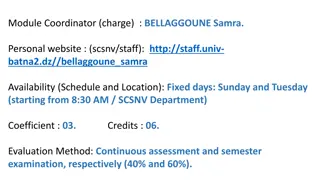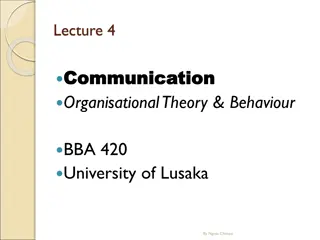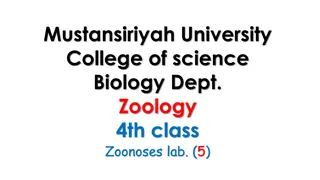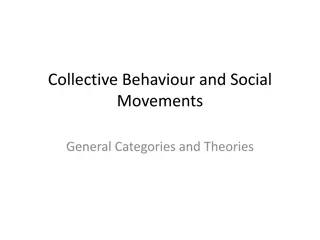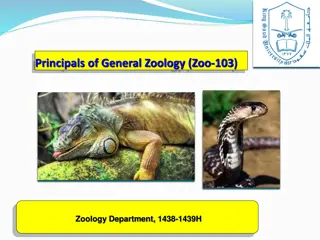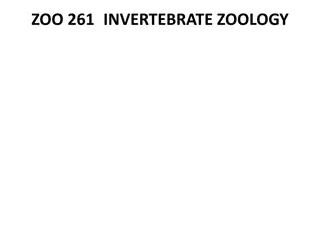Understanding Patterns of Behaviour in Zoology: An Overview
Behaviour in animals encompasses a wide range of responses to stimuli in their environment, with patterns that can be innate or learned. This comprehensive overview explores the different behavioural patterns, including tropism, taxis, reflexes, instincts, learning, and reasoning. The importance of these patterns varies among species, with some being genetically determined while others are flexible and influenced by both genes and the environment. By studying these behavioural patterns, we gain insight into how animals interact with their surroundings and adapt to survive and thrive.
Download Presentation

Please find below an Image/Link to download the presentation.
The content on the website is provided AS IS for your information and personal use only. It may not be sold, licensed, or shared on other websites without obtaining consent from the author. Download presentation by click this link. If you encounter any issues during the download, it is possible that the publisher has removed the file from their server.
E N D
Presentation Transcript
PATTERNS OF BEHAVIOUR 6THSEMESTER ZOOLOGY(MAJOR) REKHA CHETRY DEPARTMENT OF ZOOLOGY J.N.COLLEGE, BOKO,ASSAM,INDIA Email:chetryrekha@gmail.com
PATTERNS OF BEHAVIOUR BEHAVIOUR: Behaviour is what an animal does and how it does . Anything an animal does in response to a stimulus in its environment. All those processes by which an animal senses the external world and adopts itself to theenvironment BEHAVIOUR PATTERN: A behaviour pattern may be defined as a segment of behaviour which has a specificadaptive function. There are millions of different species of animals and each species behaves somewhat differently. However, there are common patterns of behaviour exhibited by many species and a few behaviourpatterns that are exhibited by all species BEHAVIOURS either Innate learned
PATTERNS OF BEHAVIOUR LEARNED BEHAVIOUR INNATE BEHAVIOUR Hard wired Instinctual Genetically determined Example: Kinesis, Reflex, Taxis , FAP BEHAVIOUR results from both gene and environment Flexible Not genetically determined
PATTERNS OF BEHAVIOUR According to Odum(1971) there are six major patterns of behaviour These are Tropism Taxis Reflexes Instinct Learning Reasoning Importance of behaviourpatterns vary according to the species. Out of these six behavioural patterns tropism is restricted to direction movement or orientation in organisms such as plants that lack nervous system.
PATTERNS OF BEHAVIOUR Distribution of various behaviourpatterns in Animal kingdom.
PATTERNS OF BEHAVIOUR TAXIS A taxis from ancient Greek meaning arrangement. A taxis is an innate behavioural response by an organism to a directional stimulusorgradient of stimulus intensity. Depending upon the orientation of an organism towards or away from the directional stimulus the taxis may be positiveor negative. Types of taxes Based upon the stimulus 13 types of taxes have been identified
PATTERNS OF BEHAVIOUR TAXIS Phototaxis( stimulation by light), aerotaxis (oxygen), anemotaxis(wind), bartotaxis( pressure), chemotaxis( chemicals), gravitaxis( gravity), galvanotaxis( electric current), hydrotaxis( moisture), magnetotaxis( magnetic field), thermotaxis ( temperature change), thigmotaxis( physical contact) , menotaxis( light compass response) and rheotaxis ( response to current of waterorair).
PATTERNS OF BEHAVIOUR TAXIS Depending on the type of sensory organs involved , taxis can be classified as Klinotaxis: where an organisms continuously samples the environment to determine the direction of a stimulus. Tropotaxis: where bilateral sense organs are used to determine the stimulus direction. Telotaxis: Similar to tropotaxis but suffices to establish the orientation movement . here single organ
PATTERNS OF BEHAVIOUR REFLEX The word reflex is derived from Latin reflexus meaning reflection. Simplest form of innate behaviour. A reflex is an automatic response no conscious control. A reflex is an automatic response to a stimulus .Simple reflexes produce rapid involuntary responses to a stimulus. This ensures that an animal respond in the way most likely to result in its survival. Simple animals use reflex action for the majority of their behaviour. The more complex animals such as humans only use reflex action in some of their behaviour. There are two types of reflexes Tonic reflexes: They are slow long lasting adjustment that maintain muscle tone, posture and equilibrium. Phasic reflexes: They are quick short lived adjust,ment found in flexure responses.
PATTERNS OF BEHAVIOUR REFLEX Reflex action: When the safety of an organism demands a very quick response the signals may be passed directly from a sensory neuron to a motor neuron for instant unthinking action. This is reflex action. Reflex arc:The anatomical pathway of a reflex is called the reflex arc. It is the nerve pathway which make fast automatic response possible. It consists of an afferent or sensory nerve, one or more interneurons within the central nervous system and an efferent ( motor, secretory orsecreto-motor) nerve. .
PATTERNS OF BEHAVIOUR REFLEX Examples of reflex: Human can control the size of the eye s pupil in response to light. Pulling hand back from hot object.. Types of reflexes: Generally there are two types of reflexes- Tonic reflexes: They are slow long lasting adjustments that maintain muscle tone , posture and equilibrium. Phasic reflexes: They are quick , short lived adjustments found flexure
PATTERNS OF BEHAVIOUR INSTINCTS Any behaviour is instinctive if it is performed without being based upon prior experience and it is therefore an expression of innate biological factors. Instincts are complex behaviour patterns which like reflexes are inborn, rather inflexible and valuable in adapting the animal to its environment. They differ from reflexes in their complexity . While reflex is a simple response of an organism to specific stimulus , instincts in contrast are inborn complex pattern of behaviour that must exist in every members of the species and that cannot be overcome by force or will. The entire body participates in instinctive behaviour and an elaborate series of action may be involved. Instincts are inherited just as the structure of tissues and organs.
PATTERNS OF BEHAVIOUR INSTINCTS Examples: The scratching behaviour of dog and European Bullfinch is a part of theirgenetic heritage. Spiderspinning webs . The widespread behaviour of scratching with hind limb crossed over a fore limb reptiles and mammals. is common to most birds ,
PATTERNS OF BEHAVIOUR Learning : Learning is any relatively permanent changes in response that occurs as a result of experience. Learning is characterized by persistent and measurable changes in behaviour which are not associated wit fatigue , altered motivation. Some information or knowledge is acquired and is then used to alter the individual s actins or responses. Learning as an adaptive behaviour allows individuals to adapt to specific environment challenges. Learning allows animals to use information about the world to tailor theirresponses to environmental change. Invertebrates such as flies , slugs and ants show an advanced form of learning when avoiding stimuli that haveelicited pain responses. Baboons have been trained to self inject psychotropic drugs which , it is presumed , improve theirquality of life .
PATTERNS OF BEHAVIOUR REASONING Reasoning is the ability to solve complex problems by behaving according to general principles rather than simply responding to the situation with simple trial and error behaviour or modification of stimulus response behaviour. The animal should be able to put together elements from its past experience into new arrangements to meet different situations. Only in higher primates and man does reasoning involving problem solving and formulation of concept becomea majorcomponentof behaviour.
PATTERNS OF BEHAVIOUR FIXED ACTION PATTERN Fixed Action Pattern( FAP): it is a sequence of unlearned innate behaviour that is unchangeable. It is a response of coordinated movements that are performed together as a unit without interruption. Each FAP is triggered by a unique stimulus variously known as sign stimulus , a key stimulus or a releaser. Once initiated it is usuallycarried to completion. . A praying mantis striking at prey is a typical example. The releaser for this FAP is any movement by a small object within striking distance . Once initiated the mantis cannot change the direction in mid strike orabort the mission if the preyescapes. Other common examples of FAP includes courtship displays, hunting or food gathering , nest building orescape movements. activities and attack
THANK YOU STAY AT HOME & STAY SAFE


